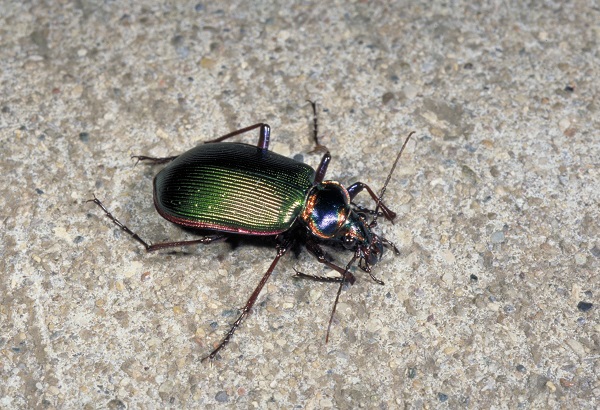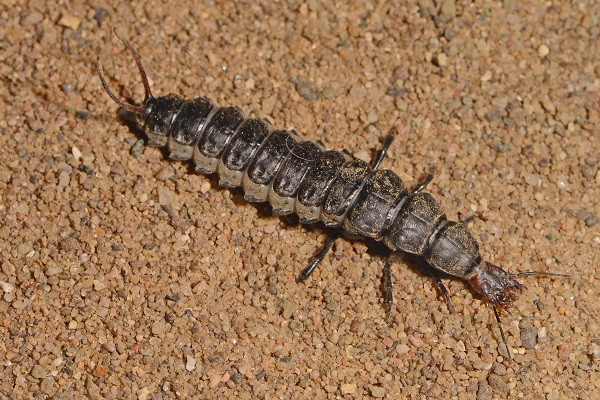Ground Beetles
ENTFACT-706: Ground Beetles | Download PDF
by Stephanie Bailey, Extension Entomologist
University of Kentucky College of Agriculture
Ground beetles make up one of the largest groups of beetles in North America, with more than 2200 species. With the wide diversity of species, they are found in many habitats including, of course, on the ground, but also in trees and other places. Ground beetles are occasionally a nuisance when may wander into homes by crawling through small openings or under doors. Generally, they will not stay indoors as they prefer the outdoors where prey is more common.

Figure 1. The large fiery searcher caterpillar hunter is a common ground beetle in Kentucky brought to the US to feed on spongy moth larvae.
Identification
Although there is some variation in their body shape and coloring, most are shiny and black (some are metallic or iridescent in color), and have ridged wing covers. Another characteristic common to ground beetles is a smaller head than thorax, and threadlike antennae. Most are oval and elongate in shape and often have prominent mandibles to devour prey. They tend to run quickly when disturbed.
Larvae are elongate and have a relatively large head with forward-projecting, curved, chewing mouthparts. The larvae live below ground, where they use their large pincher-like mandibles to devour soil-dwelling insects.
They may be confused with cockroaches such as the oriental roach (both are shiny and very dark) but beetles have hardened front wings where roaches either have leathery wings or no wings. Roaches also have a hood that conceals their head from above.

Figure 2. Ground beetle larvae and active hunters similar to the adults.
Ecological Role
Ground beetles are important predators of many insects and other soil-dwelling arthropods. Adults are active at night and tend to hide under rocks during the day. They will run when exposed. They come out at night to feed on unsuspecting insects. Likely targets include caterpillars, root maggots, snails and slugs, and other soft bodied insects. The fiery searcher, a very brilliantly colored ground beetle, was imported to assist in the control of spongy moth larvae Most species do not use their wings, but a few may fly to lights at night.
One group of ground beetles, called bombadier beetles, have an interesting defensive mechanism. When threatened, they raise the end of their body and fire a hot chemical gas with popping sound and smoke-like puffs. The gas is irritating to enemies such as toads and would-be collectors.
Nuisance Ground Beetles in the Home
As ground beetles are beneficial insects, control is generally not warranted. However, if they are creating a nuisance, reducing hiding places next to the house such as log piles, mulch, and debris around the perimeter of the foundation. Pest proofing the exterior of the home through caulking and weatherstripping can be used to seal obvious entrance points. Beetles found indoors may be swept up and discarded. If beetles are creating a nuisance by flying to lights at night, repositioning the lighting or changing white lights to yellow may reduce the attraction.
Revised: 8/22
CAUTION! Pesticide recommendations in this publication are registered for use in Kentucky, USA ONLY! The use of some products may not be legal in your state or country. Please check with your local county agent or regulatory official before using any pesticide mentioned in this publication.
Of course, ALWAYS READ AND FOLLOW LABEL DIRECTIONS FOR SAFE USE OF ANY PESTICIDE!
Photos courtesy University of Kentucky Entomology
